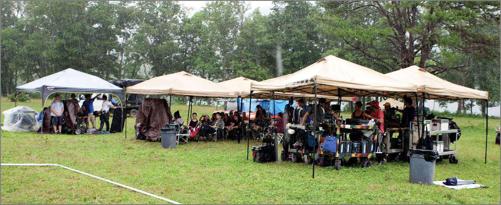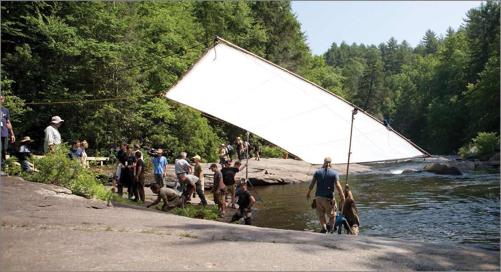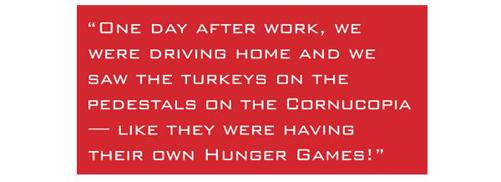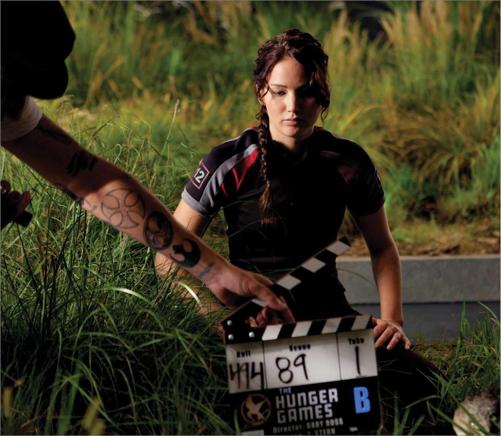The Hunger Games: Official Illustrated Movie Companion (14 page)
Read The Hunger Games: Official Illustrated Movie Companion Online
Authors: Scholastic,Kate Egan
Tags: #Juvenile Nonfiction, #Television & Radio, #Action & Adventure, #Juvenile Fiction, #Performing Arts, #General, #Science Fiction, #Social Issues, #Film, #Survival Stories


The crew shelters from the rain.

The crew preps for a scene in the DuPont State Forest.
Alli Shearmur remembers: “Joe Drake and I were there the day that Gary shot the aftermath of the tracker-jacker scene, when Katniss thinks she sees Peeta, then hallucinates that she sees Caesar Flickerman. They were doing a tremendous amount of work — and then the skies opened up. There was a torrential downpour. Everyone just stood around in their rain ponchos, cheerful as could be, because this was happening to them every day, and they knew it would stop soon. After the rain stopped, the mud was ankle-deep, and then it was like, ‘Everybody! Take your places!’ like it was no big deal at all.”
Jennifer Lawrence comments on the heat: “My Games costume was great in the fitting. It was perfect. As soon as we took it out in the hundred-and-something-degree weather, though, the leather jacket and the pants and the boots were quite different.” Still, the team kept to a strict schedule, shooting through the rain and the heat and the mud — and watching out for other potential obstacles, too.
“We had a snake wrangler — a full-time snake wrangler — on set,” Nina Jacobson points out. “We had a lot of bears. One place we shot in — North Fork, North Carolina — has one of the highest per-acre bear populations of any place in the United States.”
Not all of the animals were dangerous, but most of them were a nuisance — especially the wild turkeys. “We had wild turkeys on the set where the Cornucopia was,” recalls Isabelle Fuhrman, who plays Clove. “We’d be in the middle of a shot and the turkeys would come in and they’d send the ADs and PAs to chase them away. One day after work, we were driving home and we saw the turkeys on the pedestals on the Cornucopia — like they were having their own Hunger Games!”

Alli Shearmur remembers the experience of watching Ross shoot at night. “The woods where they shot the arena scenes were pristine. Untouched. They hadn’t been used for a movie since
The Last of the Mohicans
. The crew would bring in equipment on ATVs, sometimes put a scene together overnight. It appeared to be spontaneous, but there was an enormous amount of effort behind the scenes. I was there the night they shot the scene with the mutts. In the woods . . . in the dark . . . it was unbelievable.”

R
oss spent time with each of the actors, digging to the core of their characters. As Ross knew, an actor who understood his or her character could more easily be that person in front of the camera. The young actors, especially, were grateful for his careful approach.
“We did the scene where I was dying,” says Amandla Stenberg, “and I was talking to Gary about it, because I thought I’d be sobbing my eyes out. But he decided I shouldn’t be crying so much because my character was trying to be brave for Katniss, and that was really the start of the rebellion.”

Jennifer Lawrence prepares to practice snares in the Training Center.
Wes Bentley plays Seneca Crane in the movie. He says, “When you’re playing a character that’s not as defined as the others, you really look to your director. Gary and I talked about Seneca being this sort of cocky kid who’s never had anything bad happen to him in his life. He’s just had success after success, climbing the ladder.”
After their conversations, Ross watched Bentley closely, trying to remind him of what they’d discussed without destroying the momentum of any particular take. “Gary has such an amazing ability to feel the energy of a particular actor, to see the struggles you’re having at any moment, and to set you on the right path without you really knowing what just happened,” Bentley adds. “Gary understands the lens; he understands the performances; he understands the whole film as he’s putting it together.”
Dayo Okeniyi agrees. “Working with Gary is amazing because he has a way of making the set very calm, of making the actors feel comfortable. It feels like an indie set, being on this movie, very homey and family oriented. Gary doesn’t put pressure on the take. He’s just very light with it.
Do this; try that; no, that’s not working, let’s try it again.
He’s very much like the script is the skeleton and as an actor it’s your job to put the flesh on that.”
Ross’s approach set the tone for everything the actors did together. It could have felt arduous, but instead the shooting felt joyful and exciting. “It isn’t always the case where you’re in a constant state of laughter and merriment on a set,” says Woody Harrelson. “But it was on this one.”
“We were avid readers on the set,” says Alli Shearmur. “Gary, Jennifer, Nina. Everyone. I bought Jennifer the collected works of J. D. Salinger for her birthday. There was a real family feeling there. Josh hosted Saturday night barbecues for the cast, and everybody was always playing basketball. One night, when T-Bone Burnett was there, Gary hosted a dinner for him. Jennifer’s assistant and good friend, Justine, brought her guitar, played it beautifully but kind of shyly, and, before you knew it, T-Bone Burnett was playing, too.”
The actors playing the tributes developed a special bond. Leven Rambin says, “For a lot of us, it’s our first film. We’re in the trenches, we’re covered in mud; we’re fighting and sweating and we don’t even care. We’re just happy to be here.”
After shooting wrapped for the day, the tributes spent time exploring nearby areas, or just getting to know each other better. “Most of us are in the same hotel,” explains Jacqueline Emerson, who plays Foxface. “We go out to dinner every other night. We go to movies together. The other night I spent three or four hours just walking around with Jack and Dayo. We went to this great little bookstore and just hung out there.”

“When we’re doing all the scenes in the woods where we’re fighting, those other kids are actually our friends,” Josh Hutcherson points out. “You’re used to hanging out and laughing with them, so it’s kind of a weird transition when they say ‘Action!’ and suddenly there’s a giant bloodbath.”

W
hile the actors were exploring their characters and their new friendships, other teams were putting the pieces in place for the movie’s action sequences.
Location manager Todd Christensen had found the perfect place to film the scene where a wall of fire comes at Katniss, cornering her. “DuPont State Forest let us do a controlled burn, not only on their forest but about a quarter of a mile from the ranger’s house. For Katniss to feel like she was trapped, they put in a tree that they ratcheted so it could come down, but then she also had to fall into a rock. We had the tree — not the rock — so they put a rock in to make the drama of the scene better.”
Then special effects foreman Brandon McLaughlin rigged a wire to make it appear as if fireballs were shooting at Katniss. “It’s what we normally do when a director says, ‘I want this to go from Point A to Point B and hit it every time,’” he explains. “There’s a sixteen-inch cable right down the middle of the fireball, and we shoot it down a wire with what looks like a slingshot. The fireball itself was a steel apparatus — like a giant corkscrew — with a product wrapped on top of it that we could ignite and burn.” Any signs of the rigging would be erased in postproduction.

